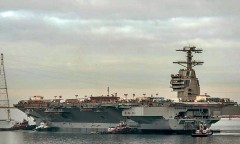By Arthur Dominic J. Villasanta , | April 08, 2017

LRASM.
Well before the first of 59 U.S. Navy UGM-109E Tomahawk Land Attack Missiles slammed into the Shayrat Air Base in Syria on April 7, the navy had already begun the process to replace this three decades-old cruise missile.
In October 2016, the U.S. Naval Air Systems Command (NAVAIR) issued a request for information (RfI) for the Next Generation Land Attack Weapon (NGLAW) for use aboard its surface warships and submarines. NGLAW has long been touted as the Tomahawk's successor and the RfI begins this long and tedious replacement process.
Like Us on Facebook
The RfI seeks information from defense industry firms on key capabilities, technical readiness levels, costs, schedules, and risks associated with the development and procurement of a NGLAW system in the 2028 to 2030 timeframe.
NAVAIR is looking at existing and emerging technologies for future ship and submarine conventional land attack and surface warfare (SuW) capabilities.
The RfI is the end result of efforts that sped-up in 2014 when the navy began testing several new next-generation cruise missiles as potential replacements for the Tomahawk.
"The key element of that weapon (NGLAW) will be its increased lethality and survivability beyond what the Tomahawk brings today," said Sean Stackley, former Assistant Secretary of the Navy (Research, Development & Acquisition (RD&A).
At the time, the navy wanted production of the Tomahawk to cease by fiscal year 2016, as provided for by its five year budget plan.
"We had been sustaining a 200 Tomahawk per year rate. In 2015 we'll drop down to 100. In 2016 we will revisit the question of whether the time is right to stop production of Tomahawks," said Stackley.
Ending Tomahawk production didn't push through, however. In December 2016, the navy awarded the Raytheon Company, Tomakawk's developer, a $303.7 million contract to provide 214 Tomahawk Block IV vertical launch missiles and spares.
This production extension didn't end efforts to replace the Tomahawk.
Stackley said the Navy was exploring several cruise missile technologies. He said the next-generation weapon could be an upgraded Tomahawk or could be another weapon.
A leading candidate among these other weapons is the Long Range Anti-Ship Missile, or LRASM, which in its current form can only be launched from aircraft. The navy is exploring a warship launched version.
LRSAM is designed to defeat advanced enemy air-defense systems using sensors and autonomous flight. The Navy plans to configure its McDonnell Douglas F/A-18 Hornet fighter jets to be able to fire the LRASM.
-
Use of Coronavirus Pandemic Drones Raises Privacy Concerns: Drones Spread Fear, Local Officials Say

-
Coronavirus Hampers The Delivery Of Lockheed Martin F-35 Stealth Fighters For 2020

-
Instagram Speeds Up Plans to Add Account Memorialization Feature Due to COVID-19 Deaths

-
NASA: Perseverance Plans to Bring 'Mars Rock' to Earth in 2031

-
600 Dead And 3,000 In The Hospital as Iranians Believed Drinking High-Concentrations of Alcohol Can Cure The Coronavirus

-
600 Dead And 3,000 In The Hospital as Iranians Believed Drinking High-Concentrations of Alcohol Can Cure The Coronavirus

-
COVID-19: Doctors, Nurses Use Virtual Reality to Learn New Skills in Treating Coronavirus Patients










